Cobras are a diverse group of venomous snakes known for their iconic hood and potent venom. Ranging across Africa and Asia, these reptiles exhibit a wide variety of appearances, behaviors, and ecological adaptations. From the agile spitting cobras to the giant king cobra, each species has evolved unique traits that help it survive in different environments. Exploring the types of cobras reveals a fascinating world of biological diversity and incredible survival strategies.
Cobras are highly distinctive venomous snakes mainly found in Africa and Asia, belonging to the family Elapidae. Their signature feature is the ability to expand their neck ribs to form a hood when threatened. The term “cobra” generally refers to members of the genus Naja, but can sometimes include certain related species due to similar behaviors (like the King Cobra, which is not a true Naja species).
Post Contents
- Classification And Overview Of Main Types Of Cobras
- 1. Naja Cobras (True Cobras)
- 2. Spitting Cobras
- 3. Other “Cobras” (Not Genus Naja)
- 4. Fossil and Extinct Cobras
- Banded Water Cobra (Naja annulata)
- Cape Cobra (Yellow Cobra) Naja nivea
- Caspian Cobra (Persian or Russian Cobra) (Naja oxiana)
- Chinese Cobra (Taiwan Cobra) (Naja atra)
- Egyptian Cobra (Asp) (Naja haje)
- Forest Cobra (Black and White-lipped Cobra) (Naja melanoleuca)
- Indian Cobra (Spectacled Cobra) (Naja naja)
- King Cobra (Ophiophagus hannah)
- Monocled Cobra (Monocellate Cobra) (Naja kaouthia)
- Philippine Cobra (Philippine Spitting Cobra) (Naja philippinensis)
- Samar Cobra (Naja samarensis)
- Rinkhals (Ring-Necked Spitting Cobra) (Hemachatus haemachatus)
- Shield-Nosed Cobras (Aspidelaps spp.)
- Goldie’s Tree Cobra (African Tree Cobra) (Naja nigricollis)
- Tree Cobras or Forest Cobras (Pseudohaje spp.)
- Water Cobra or Ringed Water Cobra (Boulengerina spp.)
- False Water Cobra (Hydrodynastes gigas)
- Some More Cobra Species
- Anchieta’s Cobra (Angolan Cobra) (Naja anchietae)
- Snouted Cobra (Banded Egyptian Cobra) (Naja annulifera)
- Moroccan Cobra (Naja antiqua)
- Arabian Cobra (N. Arabica) (Naja arabica)
- Ashe’s Spitting Cobra (Giant Spitting Cobra)
- Congo Water Cobra (Christy’s water cobra) (Naja christyi)
- Mali Cobra (Katian Spitting Cobra)
- Burrowing Cobra (Naja multifasciata)
- Andaman Cobra (Andaman Spitting Cobra) (Naja sagittifera)
- Senegalese Cobra
- Equatorial Spitting Cobra
- Mandalay Spitting Cobra (Burmese Spitting Cobra)
- Nubian Spitting Cobra
- Spanish Cobra (black-necked spitting cobra)
- Black-Necked Spitting Cobra
- Zebra Spitting Cobra
- European Cobra
- Conclusion
Classification And Overview Of Main Types Of Cobras
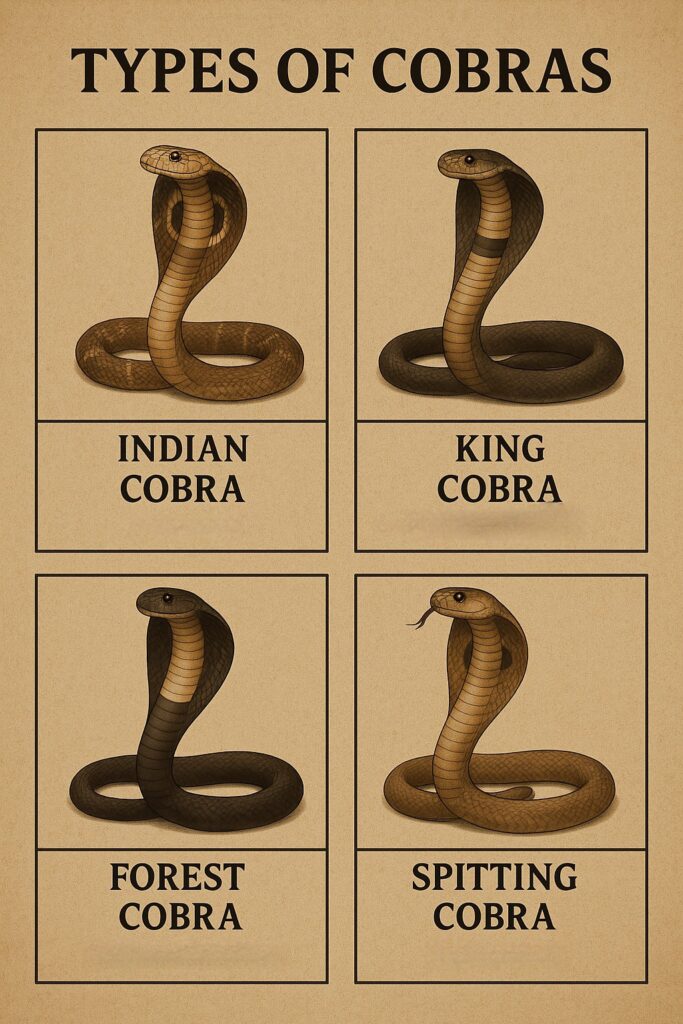
1. Naja Cobras (True Cobras)
These are the classic “hooded” cobras from the genus Naja. Nearly all spitting and non-spitting cobras fall under this genus.
Notable Naja Species:
- Indian Cobra (Naja naja) – Also known as Spectacled Cobra; found in India, Sri Lanka, and nearby regions.
- Monocled Cobra (Naja kaouthia) – Named for the monocle-shaped marking; found in South and Southeast Asia.
- Philippine Cobra (Naja philippinensis) – Native to the Philippines.
- Egyptian Cobra (Naja haje) – Native to North Africa.
- Forest Cobra (Naja melanoleuca) – Africa’s largest cobra; found in rainforest regions.
- Banded Water Cobra (Naja annulata) – Found near water bodies in Central Africa.
- Snouted Cobra (Naja annulifera) – Southern Africa.
- Chinese Cobra (Naja atra) – Southern China and Southeast Asia.
- Caspian Cobra (Naja oxiana) – Central Asia.
- Cape Cobra (Naja nivea) – Southern Africa.
- Samar Cobra (Naja samarensis) – Philippines (Visayas and Mindanao).
- Andaman Cobra (Naja sagittifera) – Andaman Islands, India.
- Black-necked Spitting Cobra (Naja nigricollis) – Sub-Saharan Africa.
- Nubian Spitting Cobra (Naja nubiae) – Northeast Africa.
- Senegalese Cobra (Naja senegalensis) – West Africa.
- Equatorial Spitting Cobra (Naja sumatrana) – Southeast Asia.
2. Spitting Cobras
Many species of Naja have evolved the ability to spit venom as a defense mechanism, especially in Africa and Asia:
- Mozambique Spitting Cobra (Naja mossambica)
- Javan Spitting Cobra (Naja sputatrix)
- Indochinese Spitting Cobra (Naja siamensis)
- Zebra Spitting Cobra (Naja nigricincta)
3. Other “Cobras” (Not Genus Naja)
Some snakes are called cobras due to their hooding behavior, but genetically distinct from Naja.
The King Cobra:
- King Cobra (Ophiophagus hannah)
The world’s largest venomous snake, reaching up to 5.6 m (18.5 ft); found from India to Southeast Asia. It mainly preys on other snakes and is the sole member of its genus, Ophiophagus.
Tree Cobras:
- Gold’s Tree Cobra (Pseudohaje goldii)
- Black Tree Cobra (Pseudohaje nigra) These are highly arboreal African species, sometimes called “tree cobras.”
Shield-Nosed Cobras:
- Shield-Nosed Cobra (Aspidelaps scutatus)
Also known as the Cape Coral Snake, found in southern Africa and recognized by the distinctive shield-like nose.
4. Fossil and Extinct Cobras
Some fossil species such as:
- European Cobra (Naja romani)
- Moroccan Cobra (Naja antiqua)
- Spanish Cobra (Naja iberica)
are known only from paleontological evidence.
Banded Water Cobra (Naja annulata)
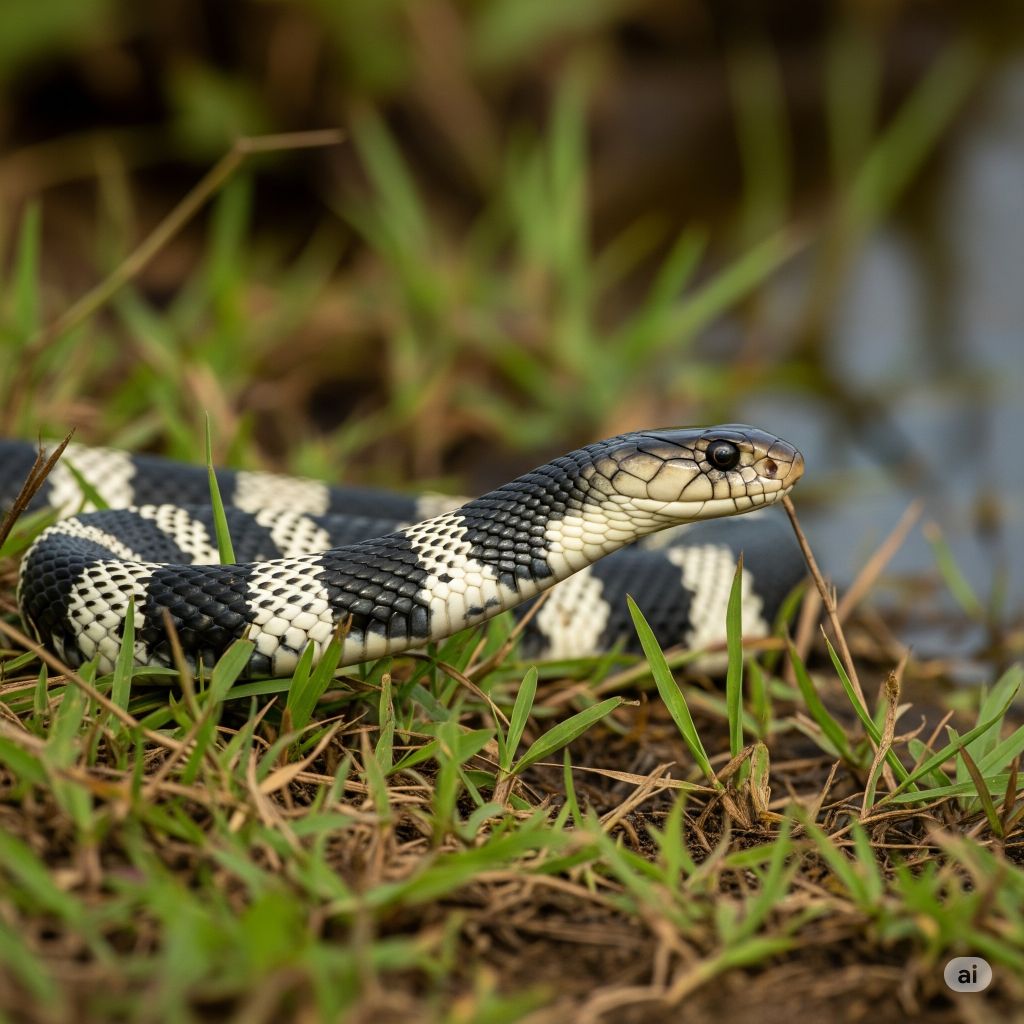
Classification
- Scientific name: Naja annulata
- Class: Reptilia
- Domain: Eukaryota
- Family: Elapidae
- Kingdom: Animalia
- Subgenus: Naja (True Cobras)
- Conservation status: Least Concern (IUCN)
Description
Characteristics: The Banded Water Cobra is characterized by its slender body and distinctive banding patterns which provide effective camouflage in its aquatic environment. Typically, these snakes display a combination of dark colors with lighter bands along their body, making them well-suited for life in wetlands and rivers.
Lifespan: This species generally lives around 10 to 15 years in the wild.
Prey and Diet: The diet primarily consists of aquatic prey, including frogs, fish, and small rodents that may come near water bodies. Their ability to hunt in water allows them to adapt well to a variety of environments.
Behavior/Venom: The venom of the Banded Water Cobra is potent and primarily cytotoxic, causing pain and tissue damage upon envenomation. When threatened, these cobras can spit venom with remarkable accuracy, primarily aiming for the eyes of their assailants.
Habitat: Banded Water Cobras are typically found in moist, aquatic environments, including rivers, swamps, and lakes. They prefer areas with dense vegetation that provide both cover and hunting grounds.
Geographic Range: This species is found in several African countries, including Cameroon, Central African Republic, the Democratic Republic of Congo, Republic of Congo, Equatorial Guinea, Gabon, Rwanda, and the province of Cabinda in Angola.
Cape Cobra (Yellow Cobra) Naja nivea
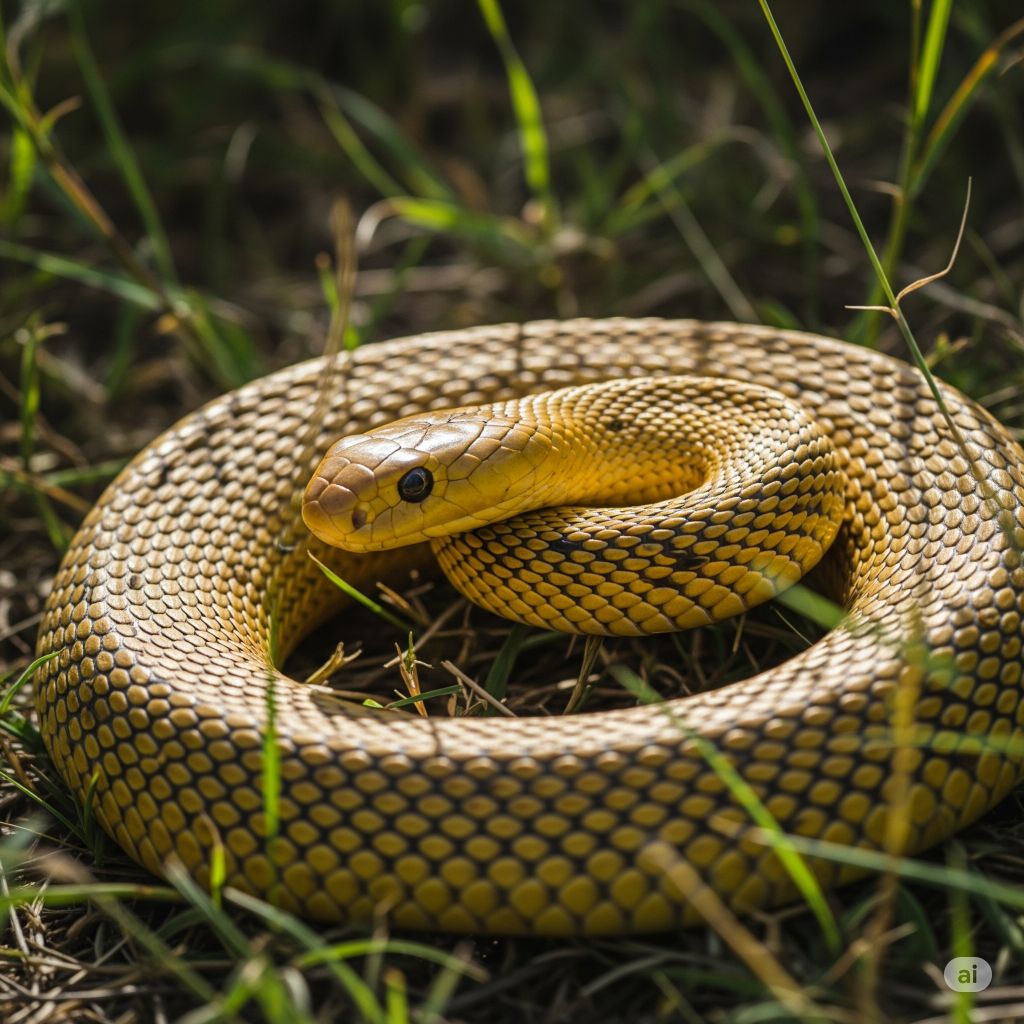
Classification
- Scientific name: Naja nivea
- Class: Reptilia
- Domain: Eukaryota
- Family: Elapidae
- Kingdom: Animalia
- Subgenus: Naja (True Cobras)
- Conservation status: Least Concern (IUCN)
Description
Characteristics: The Cape Cobra is recognized for its striking color variations ranging from yellow to brown and even black. It has a robust body and a prominent hood that displays a distinct threat posture when provoked.
Lifespan: Generally, it can live around 10-15 years in the wild.
Prey and Diet: The Cape Cobra feeds on various small mammals, birds, and other reptiles. It primarily uses its venom to subdue prey quickly.
Behavior/Venom: Its venom is primarily neurotoxic and can cause respiratory failure in humans. The Cape Cobra is known for its aggressive defensive behavior, often displaying its hood and striking when threatened.
Habitat: This species prefers arid and semi-arid habitats, including deserts and coastal regions.
Geographic Range: The Cape Cobra is found in southern Africa, primarily in South Africa, Namibia, Zimbabwe, and Botswana.
Caspian Cobra (Persian or Russian Cobra) (Naja oxiana)
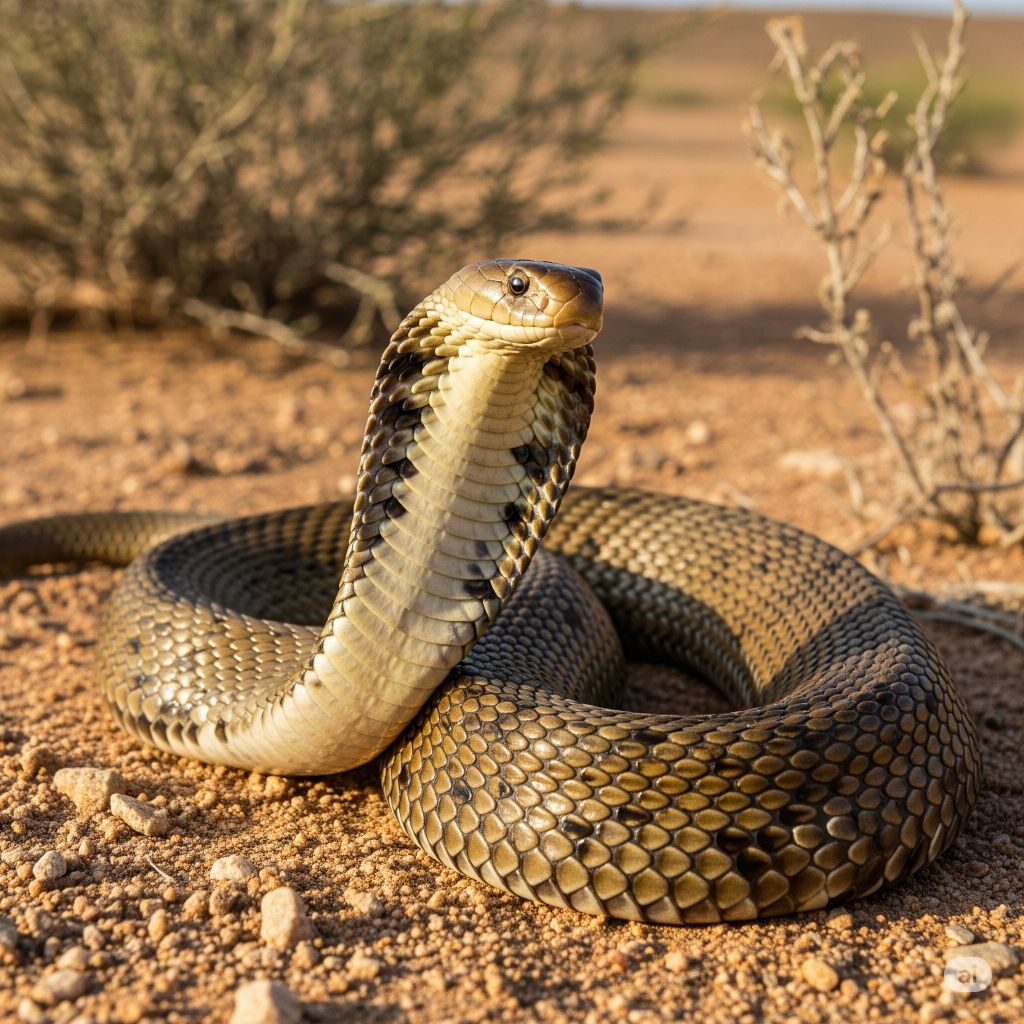
Classification
- Scientific name: Naja oxiana
- Class: Reptilia
- Domain: Eukaryota
- Family: Elapidae
- Kingdom: Animalia
- Subgenus: Naja (True Cobras)
- Conservation status: Near Threatened (IUCN)
Description
Characteristics: The Caspian Cobra has a variable coloration, typically featuring shades of brown and gray with lighter bands. Its hood is prominent and expanded during displays.
Lifespan: In the wild, it can live up to 15 years.
Prey and Diet: This cobra primarily preys on rodents and small birds, utilizing its potent venom to immobilize them quickly.
Behavior/Venom: The venom is primarily neurotoxic, posing serious risks to humans. Caspian Cobras are defensive but can be elusive in their natural habitat.
Habitat: They inhabit arid regions, including steppes and semideserts near the Caspian Sea.
Geographic Range: Found across parts of Central Asia, including Afghanistan, Iran, and parts of Turkmenistan.
Chinese Cobra (Taiwan Cobra) (Naja atra)
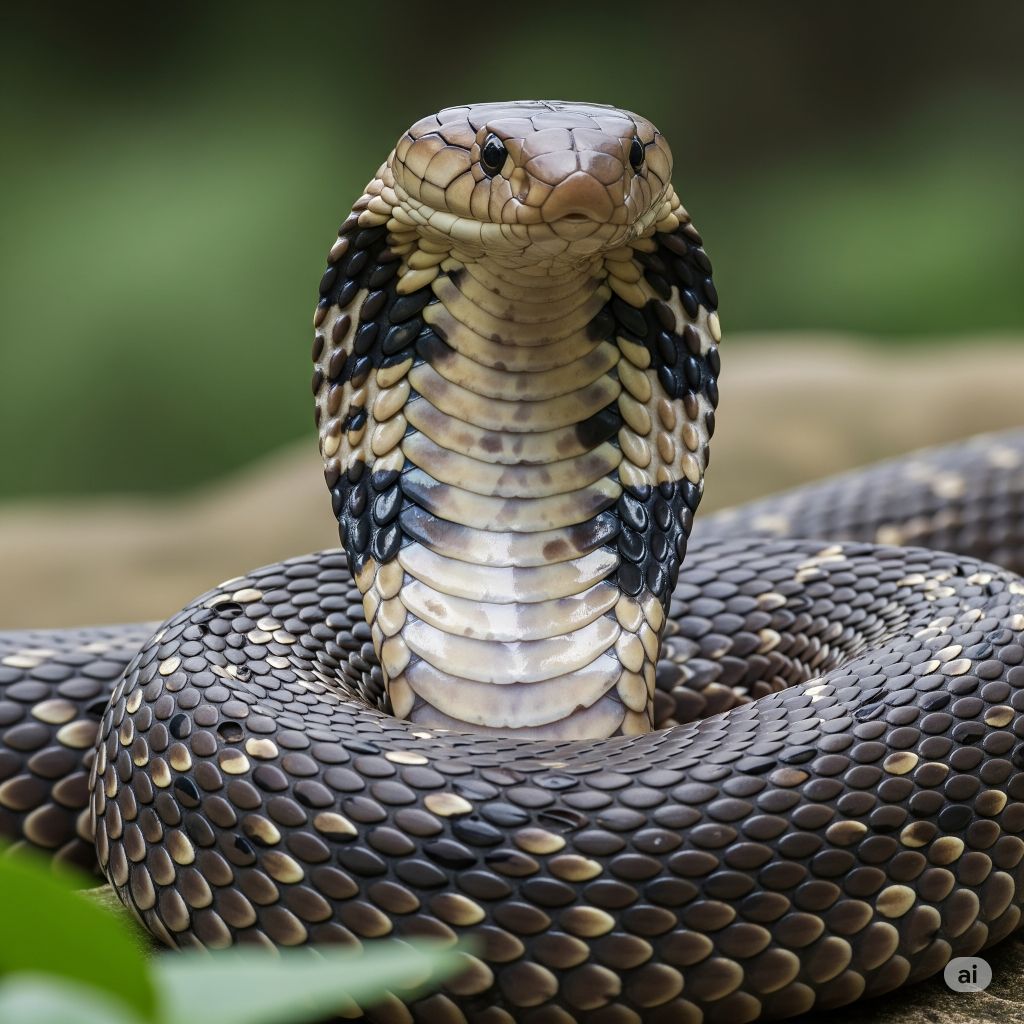
Classification
- Scientific name: Naja atra
- Class: Reptilia
- Domain: Eukaryota
- Family: Elapidae
- Kingdom: Animalia
- Subgenus: Naja (True Cobras)
- Conservation status: Least Concern (IUCN)
Description
Characteristics: The Chinese Cobra has a robust body, typically dark in color, and may display lighter patterns on its hood. It has a relatively large size, reaching lengths over 2 meters (6.5 feet).
Lifespan: The lifespan is around 10-15 years.
Prey and Diet: It preys on small mammals, birds, and reptiles, using its venom for subduing prey.
Behavior/Venom: The venom contains a mix of neurotoxic and cytotoxic properties, which can cause severe harm to humans. It exhibits aggressive behavior when threatened.
Habitat: This species prefers wooded areas, farmlands, and low-elevation habitats.
Geographic Range: Native to southern China, northern Vietnam, and parts of Laos and Taiwan.
Egyptian Cobra (Asp) (Naja haje)
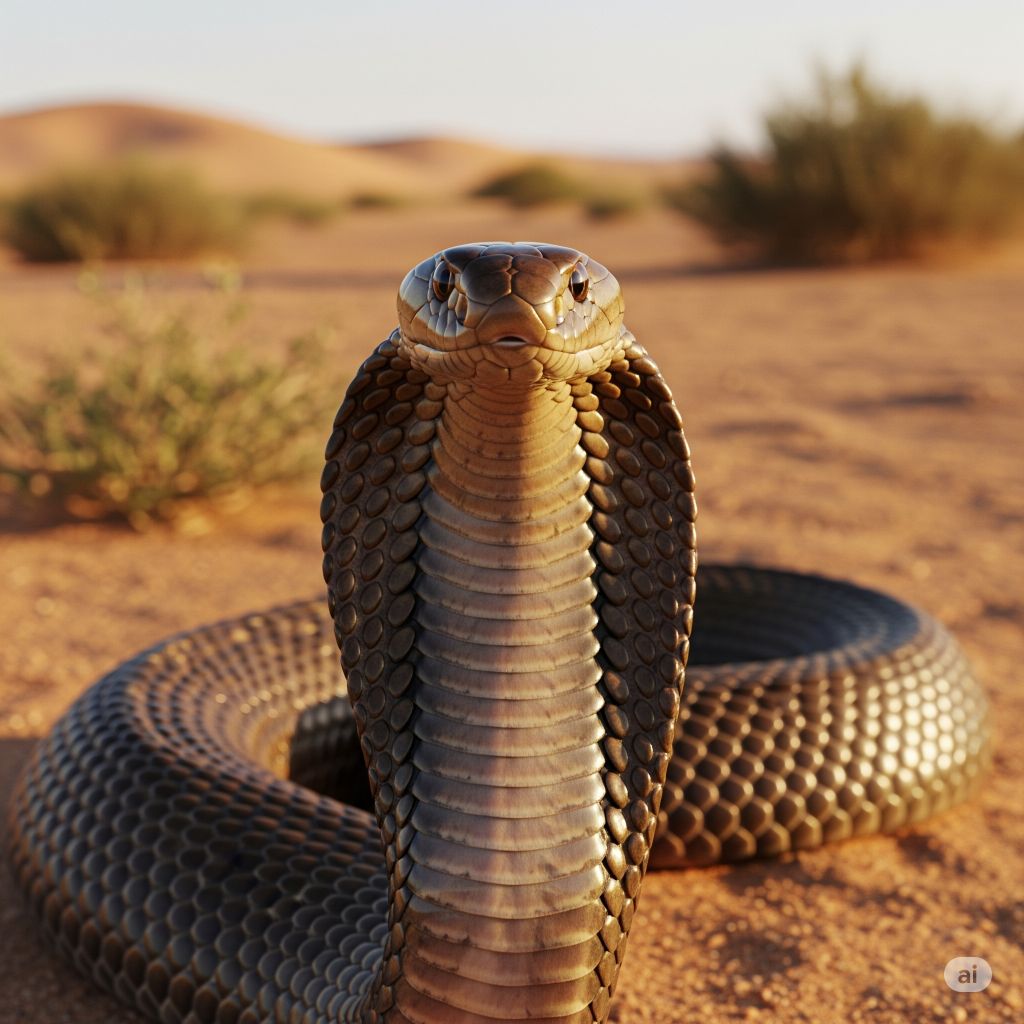
Classification
- Scientific name: Naja haje
- Class: Reptilia
- Domain: Eukaryota
- Family: Elapidae
- Kingdom: Animalia
- Subgenus: Naja (True Cobras)
- Conservation status: Least Concern (IUCN)
Description
Characteristics: The Egyptian Cobra is well-known for its hood, which it extends when threatened. Its coloration can range from yellow to dark brown, often with patterns.
Lifespan: Typically, the lifespan is around 15 years in the wild.
Prey and Diet: It primarily feeds on small mammals, birds, and occasionally other reptiles.
Behavior/Venom: The venom is significantly neurotoxic and can cause severe reactions in humans. It displays a defensive posture when threatened and can be aggressive.
Habitat: It thrives in a variety of habitats, including deserts, scrublands, and agricultural fields.
Geographic Range: Found across North Africa, particularly in Egypt, Sudan, and parts of the Middle East.
Forest Cobra (Black and White-lipped Cobra) (Naja melanoleuca)
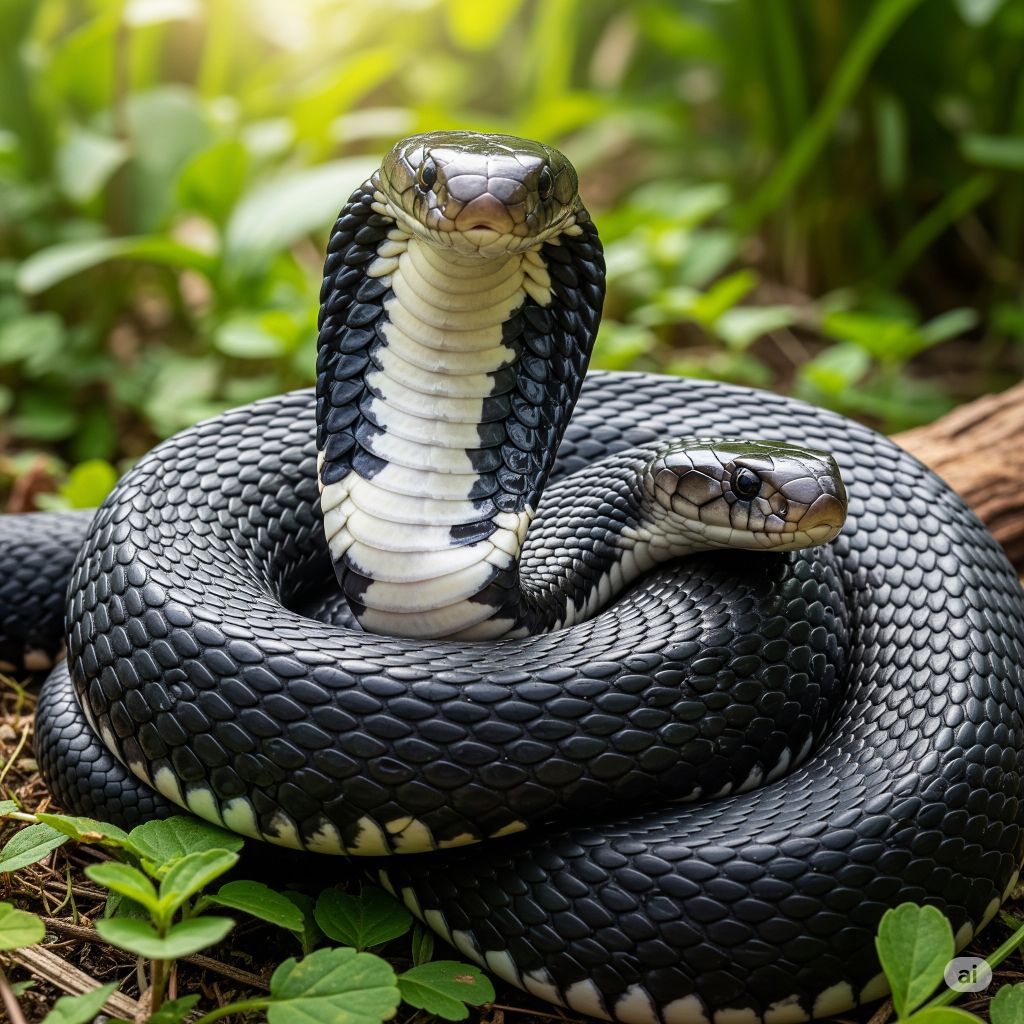
Classification
- Scientific name: Naja melanoleuca
- Class: Reptilia
- Domain: Eukaryota
- Family: Elapidae
- Kingdom: Animalia
- Subgenus: Naja (True Cobras)
- Conservation status: Vulnerable (IUCN)
Description
Characteristics: The Forest Cobra is characterized by its dark coloration, often with a glossy black appearance. It is known for its robust body and large hood.
Lifespan: Its lifespan is around 10-15 years in the wild.
Prey and Diet: This species primarily preys on small mammals and birds, using its potent venom to quickly immobilize them.
Behavior/Venom: Its venom is cytotoxic and can cause severe tissue damage. The Forest Cobra is known to be relatively secretive and prefers to avoid confrontations.
Habitat: Prefers dense forests, swamps, and habitats near water sources.
Geographic Range: Distributed across Central and West Africa.
Indian Cobra (Spectacled Cobra) (Naja naja)
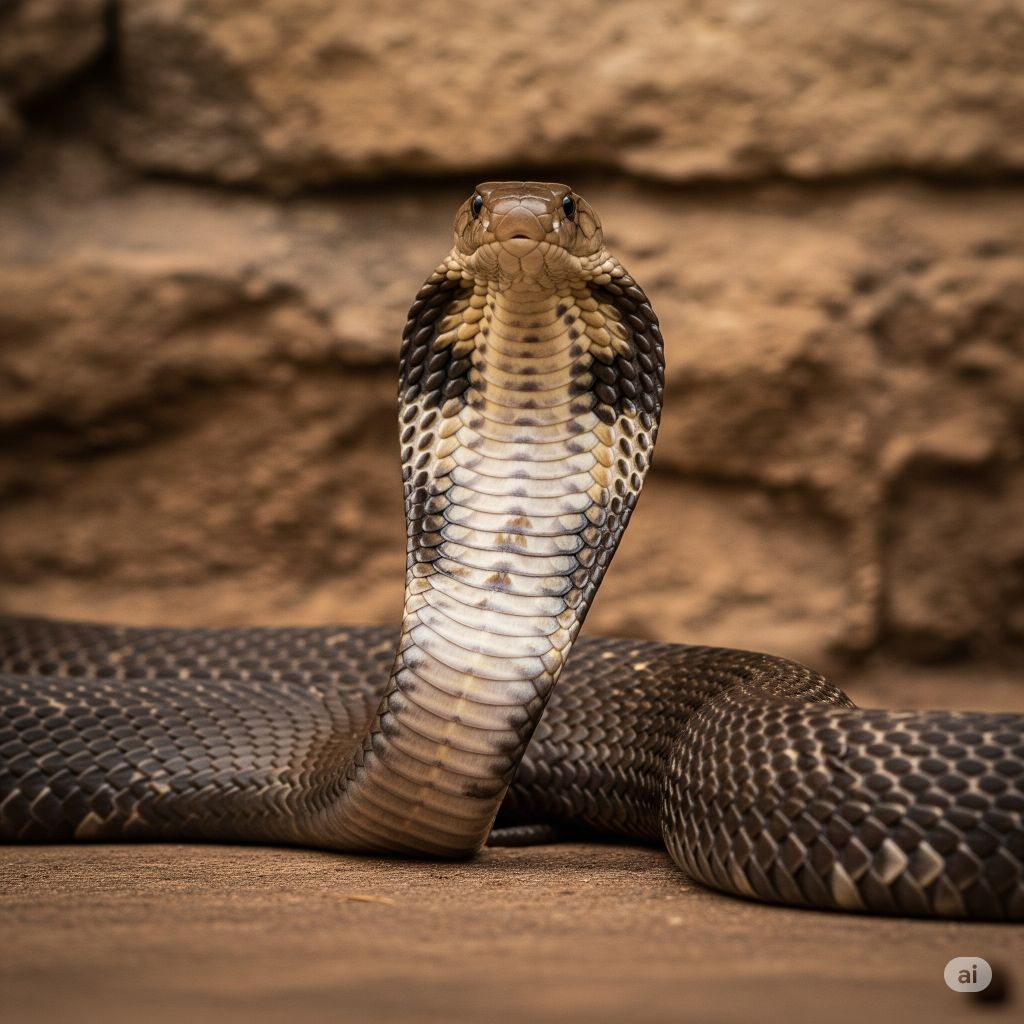
Classification
- Scientific name: Naja naja
- Class: Reptilia
- Domain: Eukaryota
- Family: Elapidae
- Kingdom: Animalia
- Subgenus: Naja (True Cobras)
- Conservation status: Least Concern (IUCN)
Description
Characteristics: The Indian Cobra, also known as the spectacled cobra, is recognized for the distinctive markings on its hood that resemble spectacles.
Lifespan: Typically, it lives around 20 years in the wild.
Prey and Diet: It feeds primarily on small mammals, amphibians, and birds, utilizing its lethal venom.
Behavior/Venom: The venom includes neurotoxic components that can lead to severe effects on the nervous system. It may exhibit a defensive posture when threatened, displaying its hood and hissing.
Habitat: Commonly found in forests, fields, and near human habitation.
Geographic Range: Native to the Indian subcontinent, including India, Bangladesh, Nepal, and Pakistan.
King Cobra (Ophiophagus hannah)
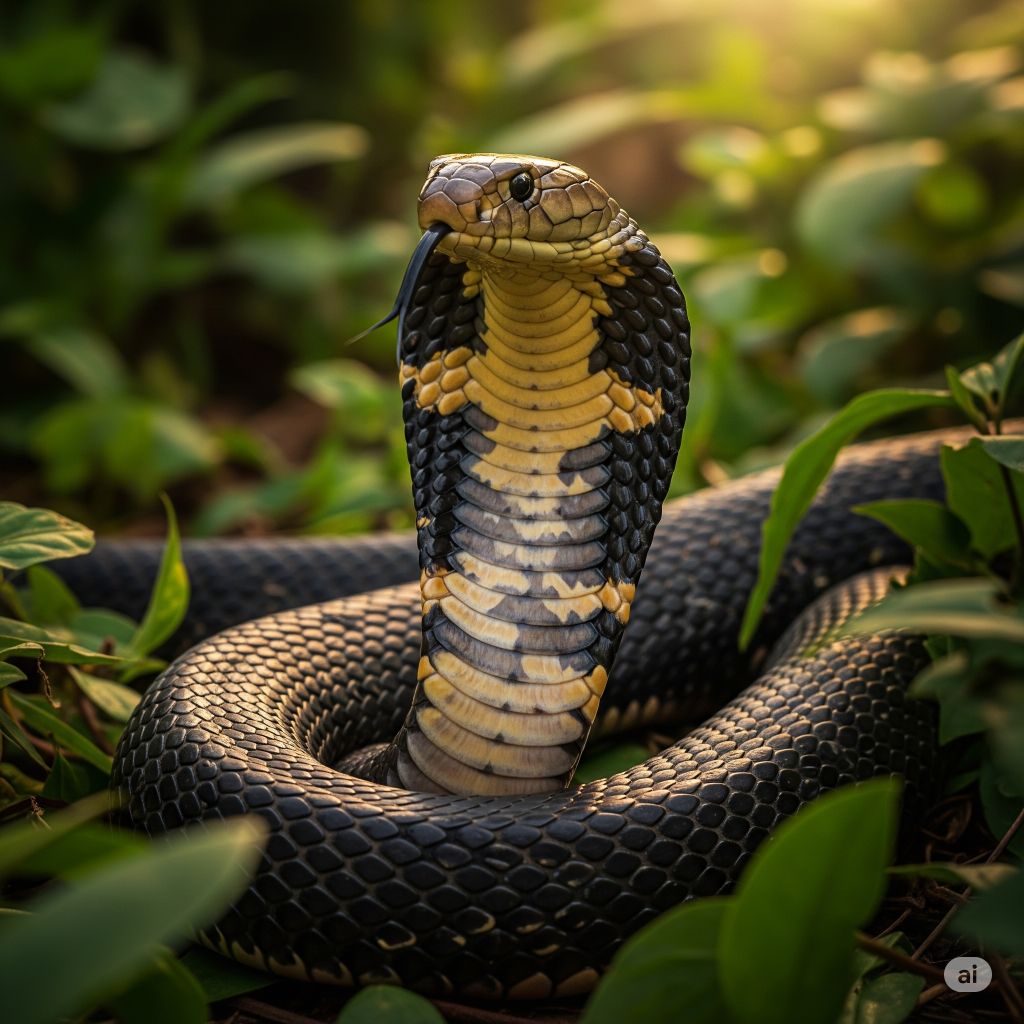
Classification
- Scientific name: Ophiophagus hannah
- Class: Reptilia
- Domain: Eukaryota
- Family: Elapidae
- Kingdom: Animalia
- Subgenus: Ophiophagus (King Cobras)
- Conservation status: Vulnerable (IUCN)
Description
Characteristics: The King Cobra is the longest venomous snake in the world, reaching lengths of up to 5.6 meters (18 feet). It has a hood that it raises when threatened.
Lifespan: The lifespan can be around 20 years or more in the wild.
Prey and Diet: It mainly preys on other snakes, including various species of cobras.
Behavior/Venom: The venom is highly neurotoxic and can cause death within hours if untreated. King Cobras are generally shy but can be aggressive when threatened.
Habitat: Prefers dense forests, particularly in areas near water sources.
Geographic Range: Found in South and Southeast Asia, including India, Bangladesh, Myanmar, Thailand, and Indonesia.
Monocled Cobra (Monocellate Cobra) (Naja kaouthia)
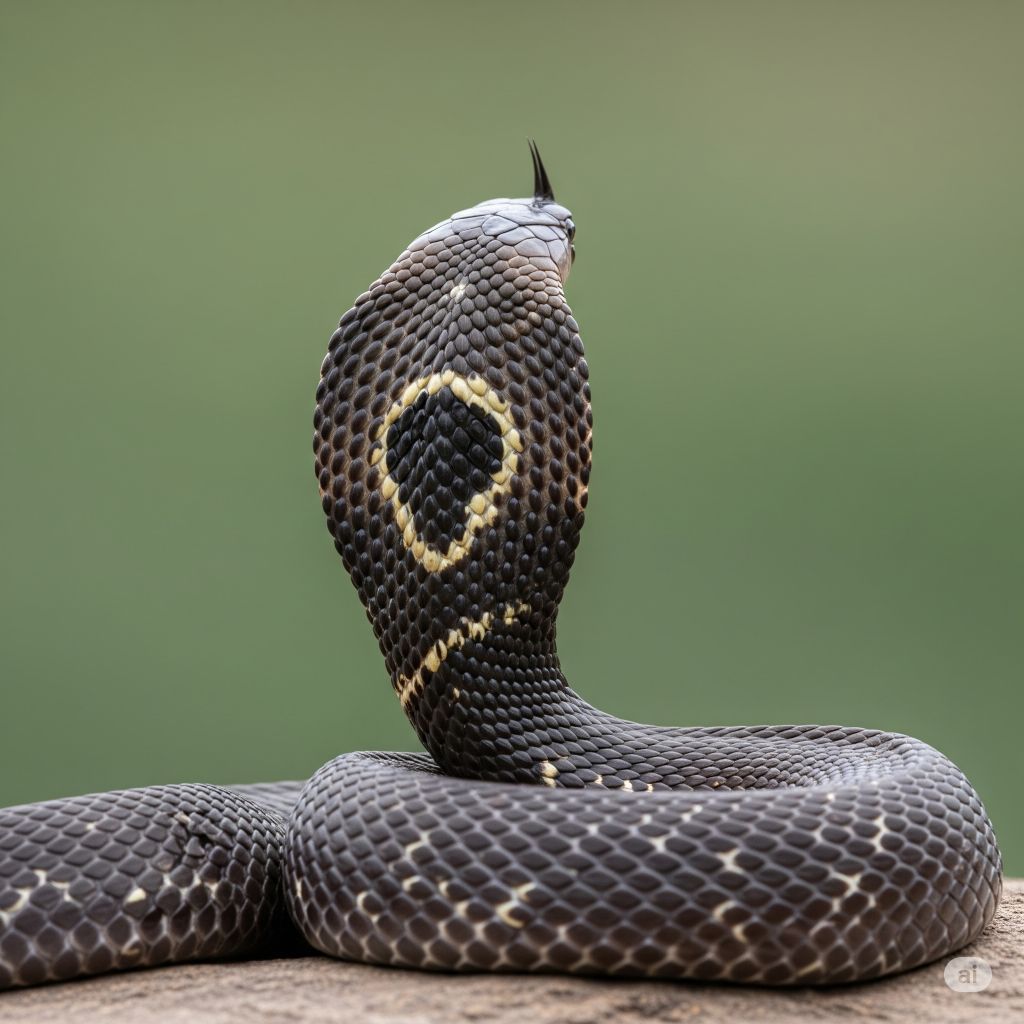
Classification
- Scientific name: Naja kaouthia
- Class: Reptilia
- Domain: Eukaryota
- Family: Elapidae
- Kingdom: Animalia
- Subgenus: Naja (True Cobras)
- Conservation status: Least Concern (IUCN)
Description
Characteristics: The Monocled Cobra has a distinct single “monocle” marking on its hood. It is typically dark brown or black in color.
Lifespan: It can live up to 15 years in the wild.
Prey and Diet: This species mainly preys on small mammals and birds.
Behavior/Venom: Its venom is neurotoxic, capable of causing paralysis. When threatened, it displays its hood and may spit venom as a defense mechanism.
Habitat: Commonly found in forests, alongside water bodies.
Geographic Range: Distributed across Southeast Asia, especially in Thailand, India, and Laos.
Philippine Cobra (Philippine Spitting Cobra) (Naja philippinensis)
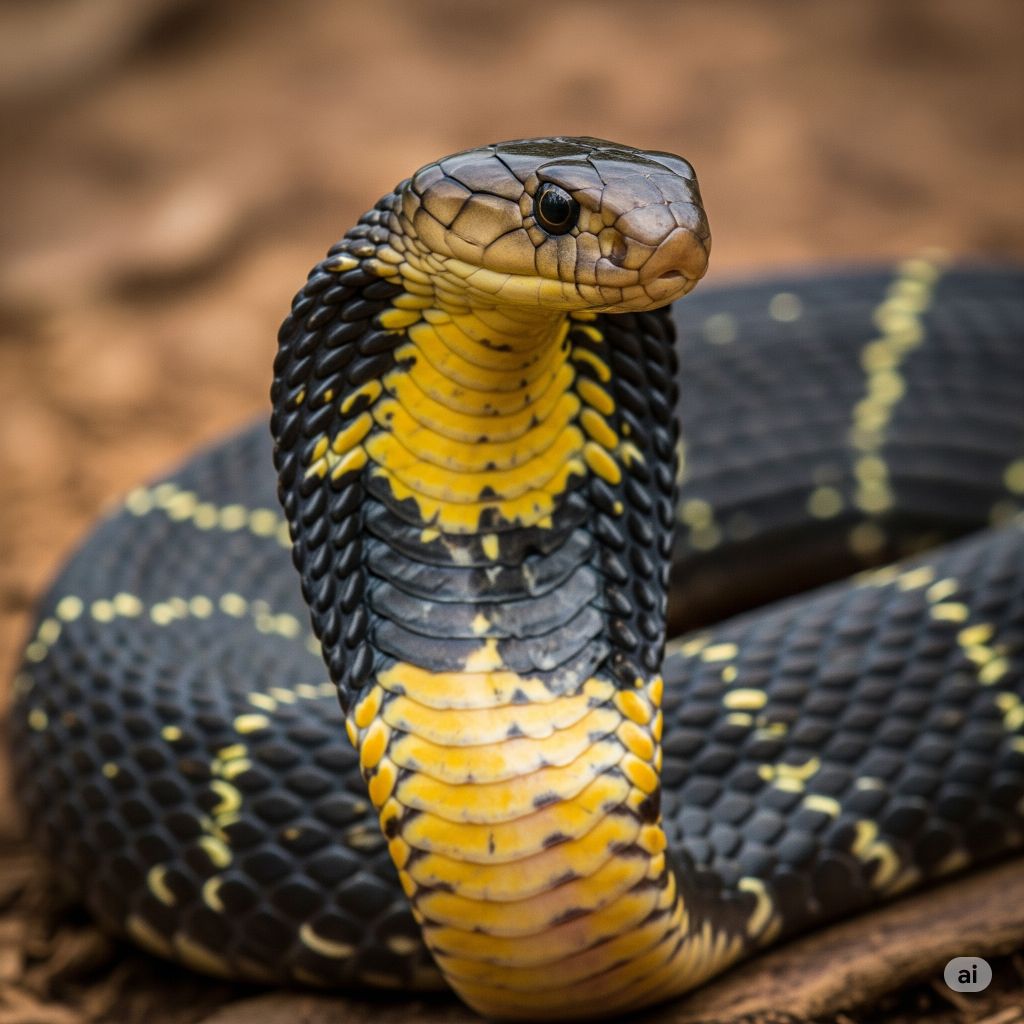
Classification
- Scientific name: Naja philippinensis
- Class: Reptilia
- Domain: Eukaryota
- Family: Elapidae
- Kingdom: Animalia
- Subgenus: Naja (True Cobras)
- Conservation status: Near Threatened (IUCN)
Description
Characteristics: The Philippine Cobra is slender and features a grayish or brown coloration. It has a distinctive hood that it expands when threatened.
Lifespan: Typically lives around 10-12 years.
Prey and Diet: This cobra feeds on small mammals, particularly rodents and amphibians.
Behavior/Venom: Its venom has potent neurotoxic effects, causing paralysis and, potentially, death. It is known to be aggressive when defending itself.
Habitat: Prefers habitats near water, including rice fields and urban areas.
Geographic Range: Endemic to the Philippines, especially in Luzon and Mindanao.
Samar Cobra (Naja samarensis)
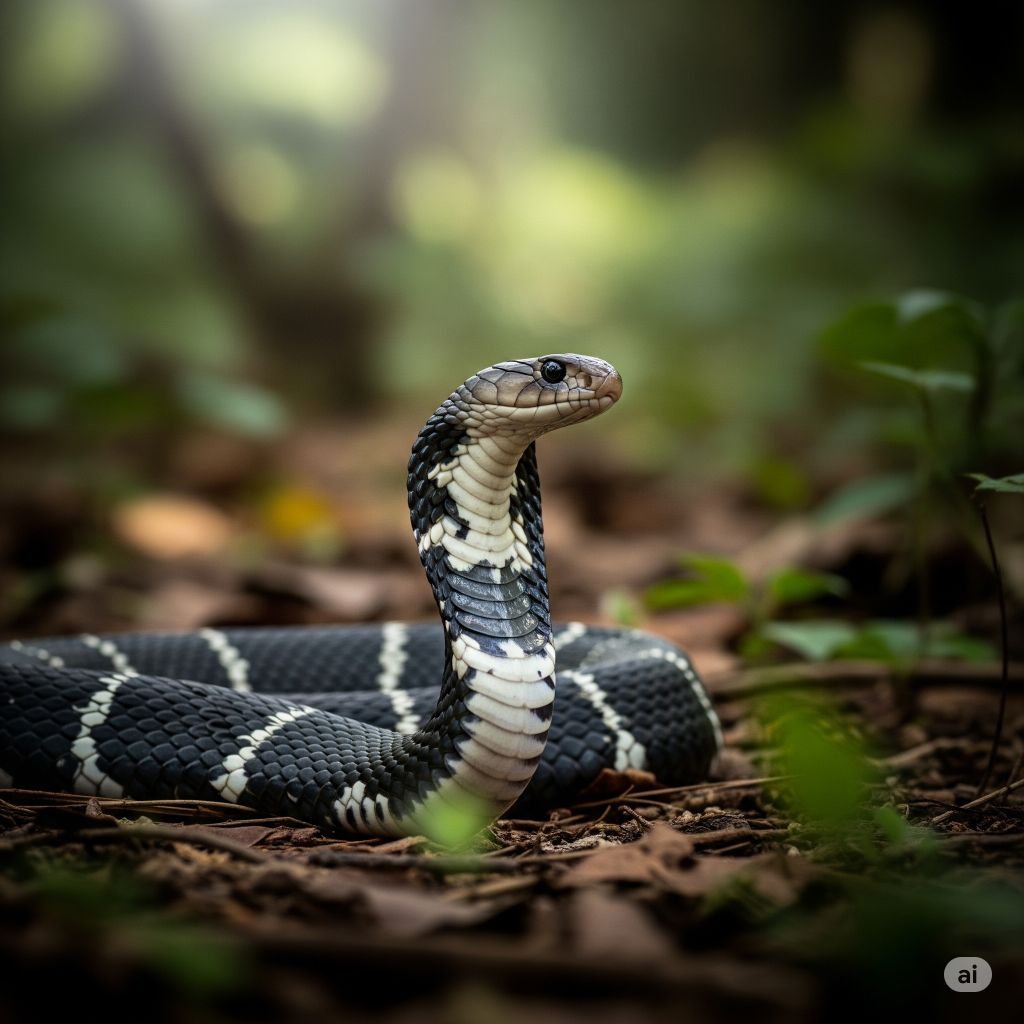
Classification
- Scientific name: Naja samarensis
- Class: Reptilia
- Domain: Eukaryota
- Family: Elapidae
- Kingdom: Animalia
- Subgenus: Naja (True Cobras)
- Conservation status: Data Deficient (IUCN)
Description
Characteristics: The Samar Cobra exhibits a robust body with a characteristic hood. Its coloration ranges from brown to gray.
Lifespan: Lifespan details are less documented but expected to be similar to other cobras, around 10 to 15 years.
Prey and Diet: Primarily feeds on small rodents and other small animals.
Behavior/Venom: This species is known for its defensive behavior, and its venom is neurotoxic. Like other cobras, it can also spit venom to deter threats.
Habitat: Found in forested areas and grasslands.
Geographic Range: Endemic to the Philippines, particularly in the islands of Mindanao and Samar.
Rinkhals (Ring-Necked Spitting Cobra) (Hemachatus haemachatus)
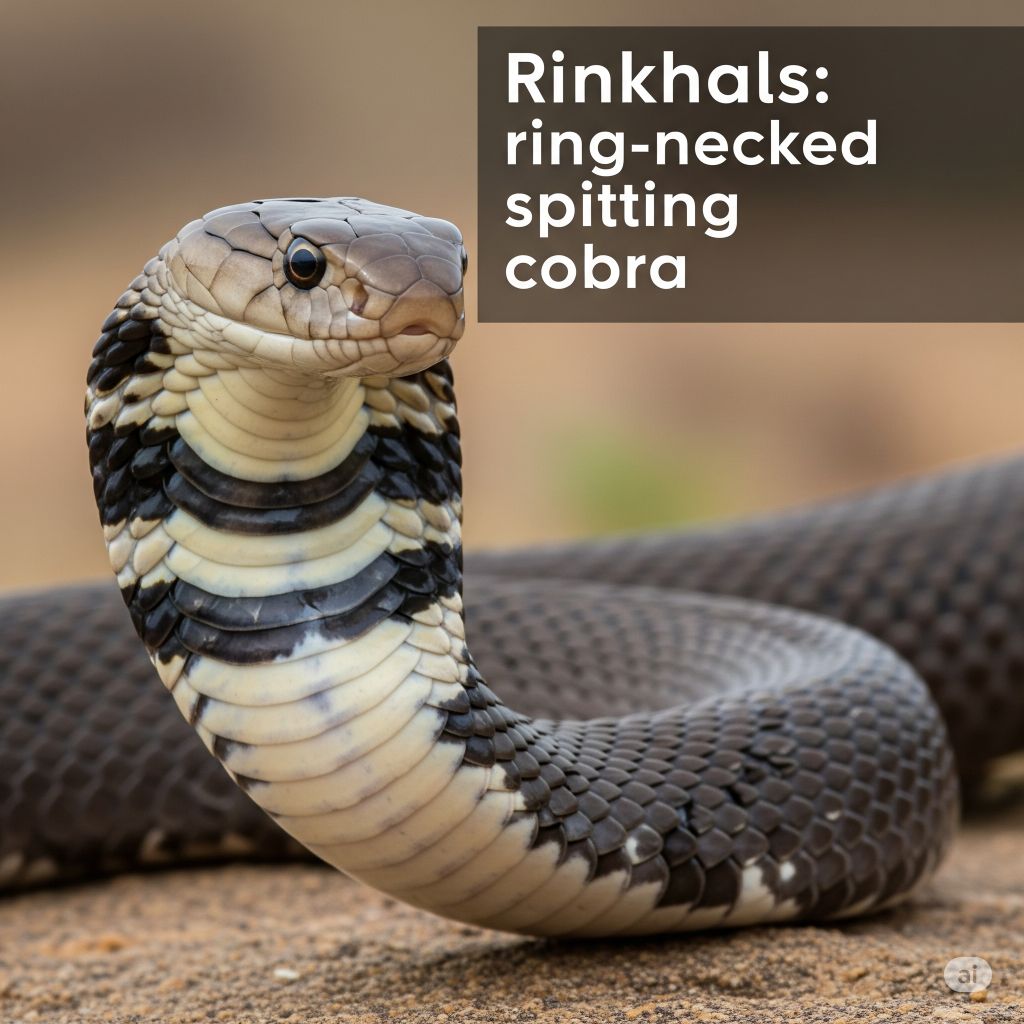
Classification:
- Class: Reptilia
- Domain: Eukaryota
- Family: Elapidae
- Kingdom: Animalia
Description:
Rinkhals is characterized by its dark body with distinctive ring markings around its neck. It has a robust build and can be quite defensive.
Geographic Range: Primarily found in southern Africa, particularly in South Africa, Namibia, and Botswana.
Behavior: Known for its behavior of mimicking being dead when threatened, it also possesses potent venom and can spit accurately when defending itself.
Shield-Nosed Cobras (Aspidelaps spp.)

Classification:
- Class: Reptilia
- Domain: Eukaryota
- Family: Elapidae
- Kingdom: Animalia
Description:
The Shield-Nosed Cobra has a distinctive broadened, flattened head that resembles a shield. Its body is typically slender, and it is relatively small compared to other cobras.
Geographic Range: Often found in southern Africa, including regions in South Africa, Namibia, Zambia, and Botswana.
Behavior: These snakes exhibit a secretive nature and are often found burrowing in sandy soils. They primarily feed on small rodents and lizards.
Goldie’s Tree Cobra (African Tree Cobra) (Naja nigricollis)
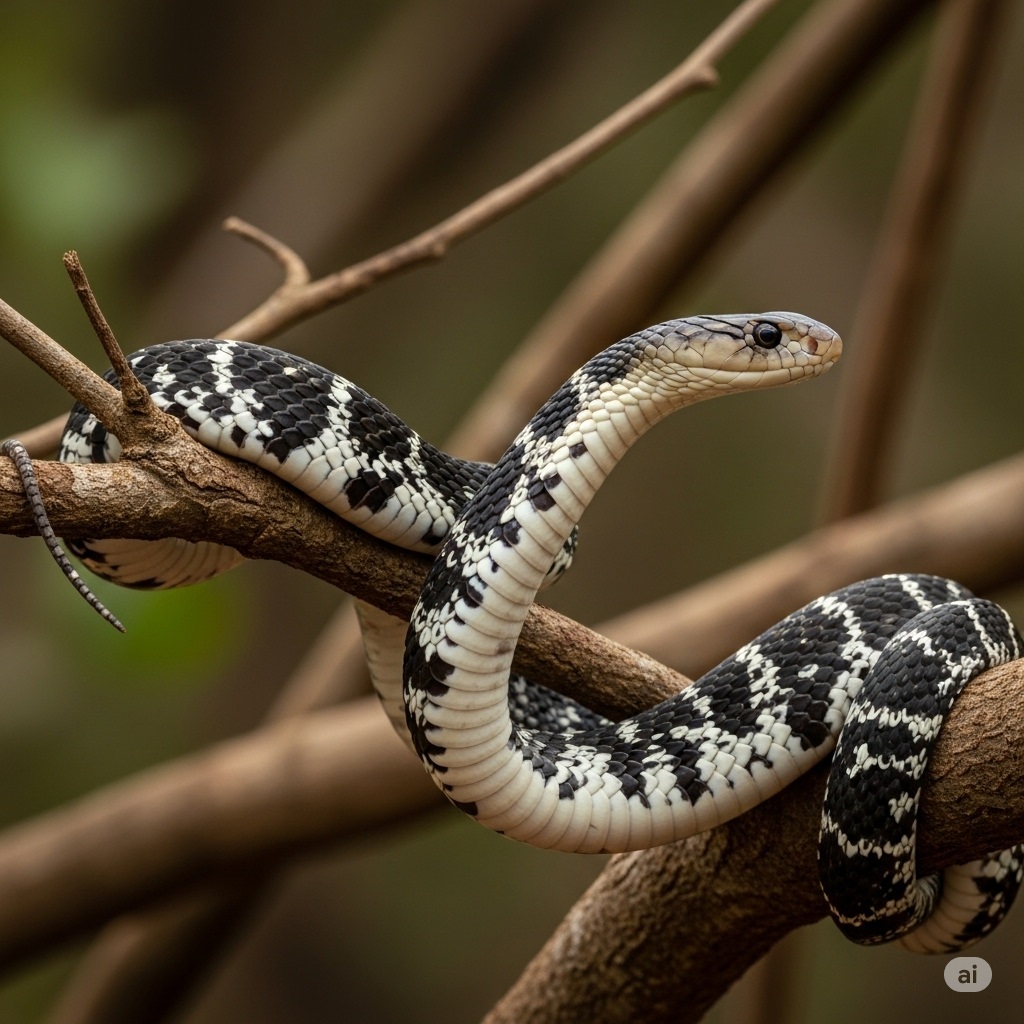
Classification:
- Class: Reptilia
- Domain: Eukaryota
- Family: Elapidae
- Kingdom: Animalia
Description:
Goldie’s Tree Cobra is a slender, arboreal species with a long body and a prominent hood. It has a varied coloration, often featuring green or brown tones to blend in with its forest habitat.
Geographic Range: Found in central and west Africa, primarily inhabiting forested areas and trees.
Behavior: This species is known for its climbing ability and can be seen resting on branches. Like other cobras, it can deliver its venom through bites or spitting.
Tree Cobras or Forest Cobras (Pseudohaje spp.)
Classification:
- Class: Reptilia
- Domain: Eukaryota
- Family: Elapidae
- Kingdom: Animalia
Description:
Tree Cobras, or Forest Cobras, have a slender body and usually exhibit a dark coloration. They are adapted for life in trees and have excellent climbing abilities.
Geographic Range: Found in Central and West Africa, primarily in forested regions and dense vegetation.
Behavior: These cobras are not known for spitting venom but are highly venomous and can deliver a potent bite. They primarily hunt small mammals and birds.
Water Cobra or Ringed Water Cobra (Boulengerina spp.)
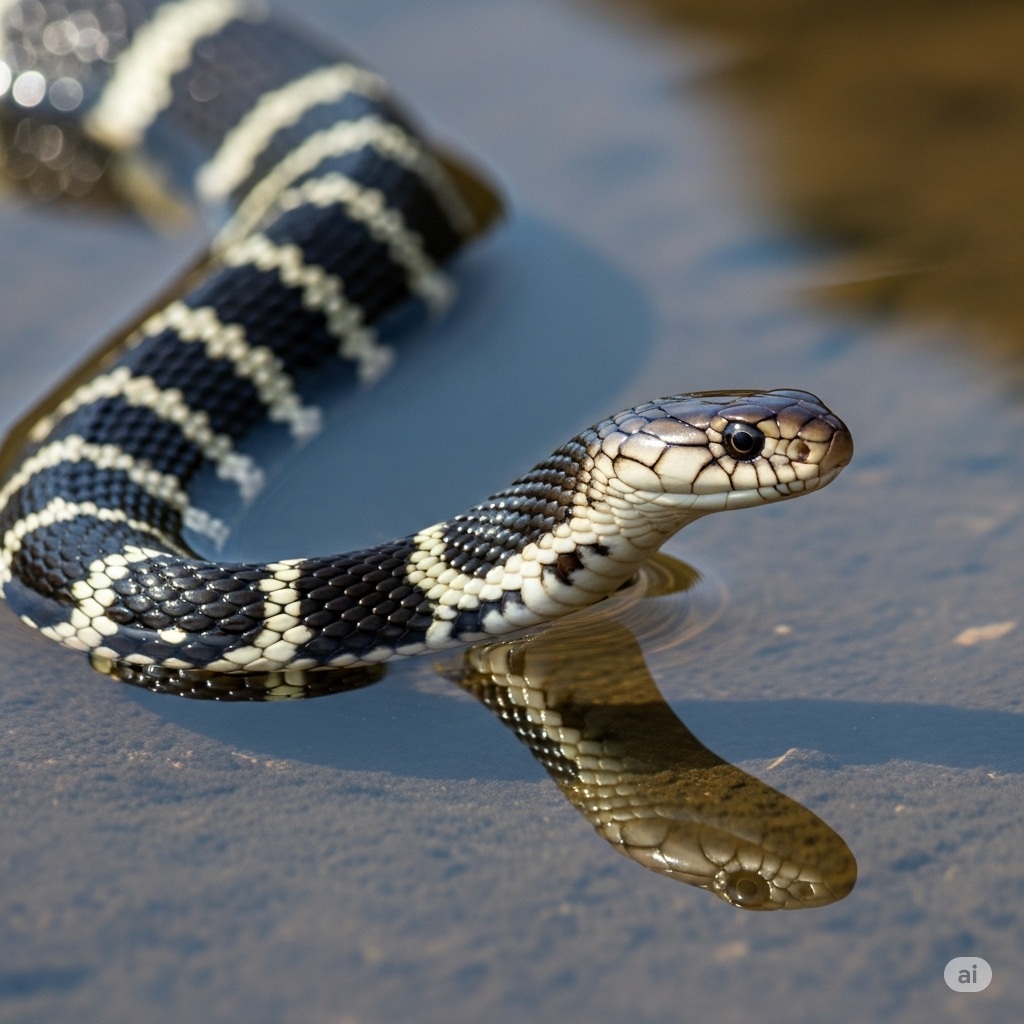
Classification:
- Class: Reptilia
- Domain: Eukaryota
- Family: Colubridae
- Kingdom: Animalia
Description:
Boulengerina, or the Ringed Water Cobra, has a long, slender body with distinctive ring patterns. It is agile and well-adapted for life in aquatic environments.
Geographic Range: Found in various countries across Central Africa, inhabiting freshwater bodies like rivers and lakes.
Behavior: Although not venomous, these snakes can deliver bites when threatened. They primarily feed on fish and amphibians, demonstrating excellent swimming abilities.
False Water Cobra (Hydrodynastes gigas)
Classification:
- Class: Reptilia
- Domain: Eukaryota
- Family: Colubridae
- Kingdom: Animalia
Description:
The False Water Cobra is a non-venomous colubrid snake that resembles true cobras. Its body is elongated and can vary in color, typically displaying a mix of browns, grays, and creams with dark banding.
Geographic Range: Found throughout South America, particularly in Brazil, Paraguay, and Argentina, often inhabiting wetland areas and riverbanks.
Behavior: Despite its cobra-like appearance, the False Water Cobra is not venomous. It is known for its aggressive temperament when threatened, and like true cobras, it can flatten its neck. This species primarily feeds on amphibians and fish.
Some More Cobra Species
Anchieta’s Cobra (Angolan Cobra) (Naja anchietae)
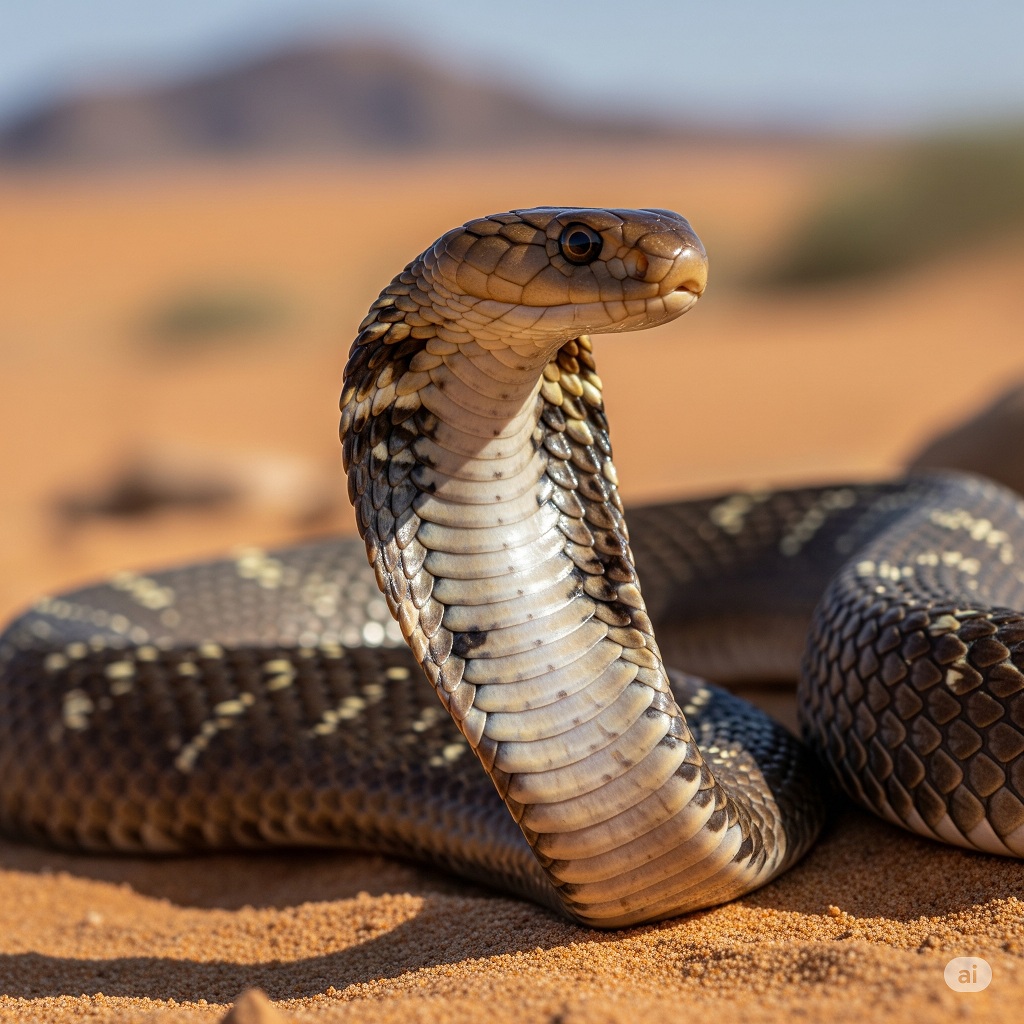
Classification
- Scientific name: Naja anchietae
- Class: Reptilia
- Domain: Eukaryota
- Family: Elapidae
- Kingdom: Animalia
- Subgenus: Naja
- Conservation status: Least Concern (IUCN)
Characteristics:
Anchieta’s Cobra features a smooth, shiny finish with a unique coloration ranging from yellow to light brown. It has a robust body and a prominent hood that it displays when threatened.
Lifespan:
Typically lives around 10-15 years in the wild.
Prey and Diet:
This species primarily preys on small mammals, birds, and occasionally other reptiles, using its potent venom for immobilizing prey.
Behavior/Venom:
Anchieta’s Cobra is known for its defensive behavior, including hissing and hood display. Its venom is potent, capable of causing serious harm to humans.
Habitat:
It prefers arid and semi-arid environments, including scrublands and savannas.
Geographic Range:
Found in Angola, Botswana, Namibia, Zambia, and eastern Zimbabwe.
Snouted Cobra (Banded Egyptian Cobra) (Naja annulifera)
Classification
- Scientific name: Naja annulifera
- Class: Reptilia
- Domain: Eukaryota
- Family: Elapidae
- Kingdom: Animalia
- Subgenus: Naja
- Conservation status: Least Concern (IUCN)
Characteristics:
The Snouted Cobra is identified by its distinct snout and moderate size. It has a robust, dark body and a pronounced hood.
Lifespan:
Typically lives around 10-15 years in the wild.
Prey and Diet:
Primarily feeds on small mammals, birds, and reptiles, utilizing its potent venom to immobilize its prey quickly.
Behavior/Venom:
This cobra exhibits aggressive behavior and possesses neurotoxic venom capable of causing significant harm to humans if bitten.
Habitat:
Preferring dry, arid regions, it can often be found in savannas and scrublands across its range.
Geographic Range:
Present in Botswana, Malawi, Mozambique, South Africa, Swaziland, Zambia, and Zimbabwe.
Moroccan Cobra (Naja antiqua)
Classification
- Scientific name: Naja antiqua
- Class: Reptilia
- Domain: Eukaryota
- Family: Elapidae
- Kingdom: Animalia
- Subgenus: Naja
- Conservation status: Data Deficient (IUCN)
Characteristics:
Known primarily from fossil records, it features characteristics common to other cobras, although its living relatives share similar venomous traits.
Lifespan:
Details are less documented due to its limited modern study, but other cobras typically live around 10-15 years.
Prey and Diet:
Little is known about its specific diet, but like other cobras, it likely preys on small mammals and birds.
Behavior/Venom:
The venom characteristics are inferred from its relatives, primarily comprising neurotoxic components.
Habitat:
Found predominantly in Miocene-aged strata of Morocco.
Geographic Range:
Primarily known from fossil records rather than living specimens.
Arabian Cobra (N. Arabica) (Naja arabica)
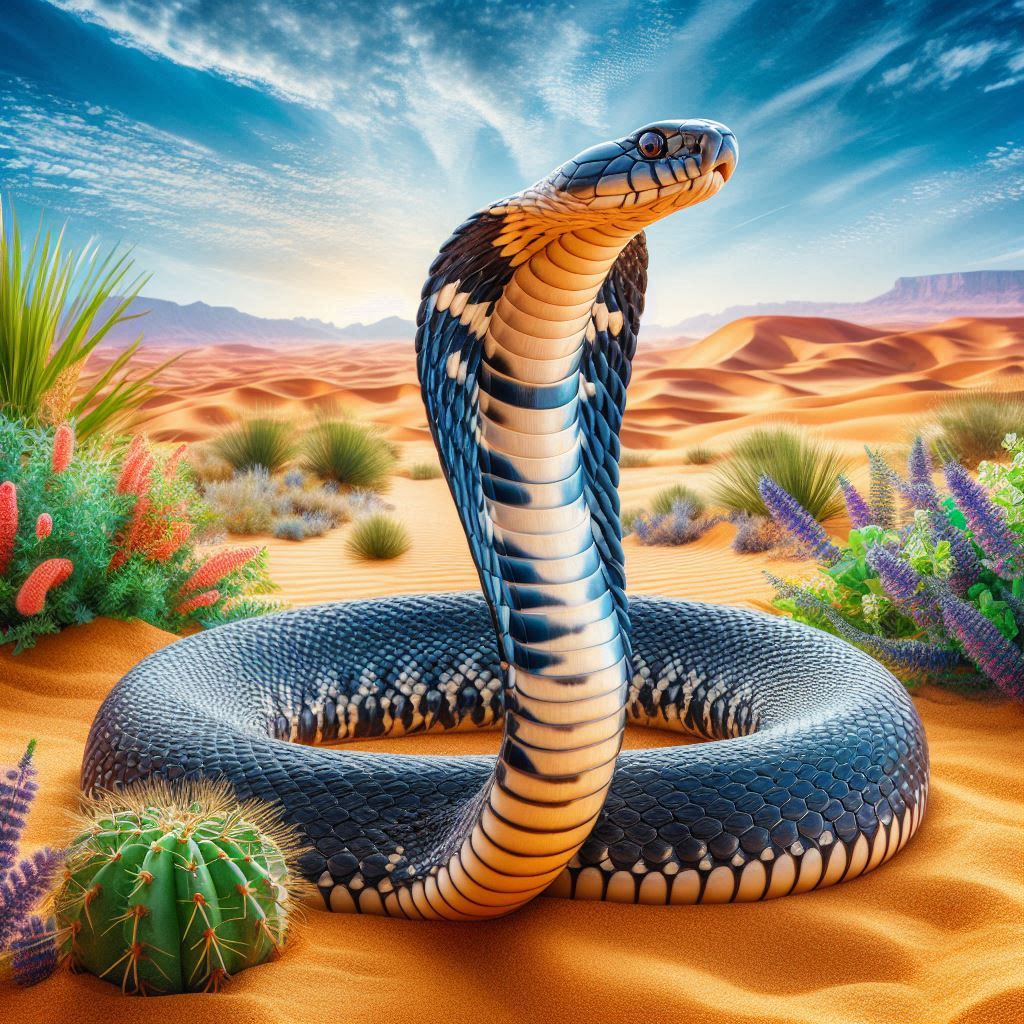
Classification
- Scientific name: Naja arabica
- Class: Reptilia
- Domain: Eukaryota
- Family: Elapidae
- Kingdom: Animalia
- Subgenus: Naja
- Conservation status: Least Concern (IUCN)
Characteristics:
The Arabian Cobra has a slender body and a prominent hood, generally exhibiting a range of colors including browns and yellows.
Lifespan:
Typically lives around 10-15 years.
Prey and Diet:
Primarily feeds on small mammals and birds, using its venom to immobilize prey effectively.
Behavior/Venom:
The venom is both cytotoxic and neurotoxic, making it dangerous to its prey and potential threats.
Habitat:
Inhabiting arid regions, the Arabian Cobra is found in deserts and scrublands in its range.
Geographic Range:
Found in Oman, Saudi Arabia, and Yemen.
Ashe’s Spitting Cobra (Giant Spitting Cobra)
Classification
- Scientific name: Naja ashei
- Class: Reptilia
- Domain: Eukaryota
- Family: Elapidae
- Kingdom: Animalia
- Subgenus: Naja
- Conservation status: Least Concern (IUCN)
Characteristics:
Recognized for its size, this cobra can grow to over 2 meters and is known for its distinct spitting behavior.
Lifespan:
Typically lives around 10-15 years.
Prey and Diet:
Ashe’s Cobra primarily preys on small mammals and birds. Its ability to spit venom allows it to defend itself effectively.
Behavior/Venom:
The venom contains potent neurotoxic components, making it highly dangerous to its aggressors. This species is known for its defensive capabilities.
Habitat:
Inhabiting various habitats from woodlands to savannas, it prefers regions with abundant prey.
Geographic Range:
Found in Southern Ethiopia, Kenya, Somalia, and eastern Uganda.
Congo Water Cobra (Christy’s water cobra) (Naja christyi)

Classification
- Scientific name: Naja christyi
- Class: Reptilia
- Domain: Eukaryota
- Family: Elapidae
- Kingdom: Animalia
- Subgenus: Naja
- Conservation status: Data Deficient (IUCN)
Characteristics:
This less commonly seen species prefers moist habitats and has a smooth body with a characteristic hood.
Lifespan:
Details on lifespan are limited but may be similar to other cobra species (around 10-15 years).
Prey and Diet:
Primarily feeds on small aquatic prey, including fish and amphibians. Uses its venom for both prey immobilization and self-defense.
Behavior/Venom:
Known for its spitting capability, the Congo Water Cobra’s venom is effective at subduing prey and can be harmful to potential threats.
Habitat:
Preferring freshwater environments, it is found in swamps, rivers, and lakes.
Geographic Range:
Found in the Democratic Republic of Congo, Republic of Congo, and Cabinda in Angola.
Mali Cobra (Katian Spitting Cobra)
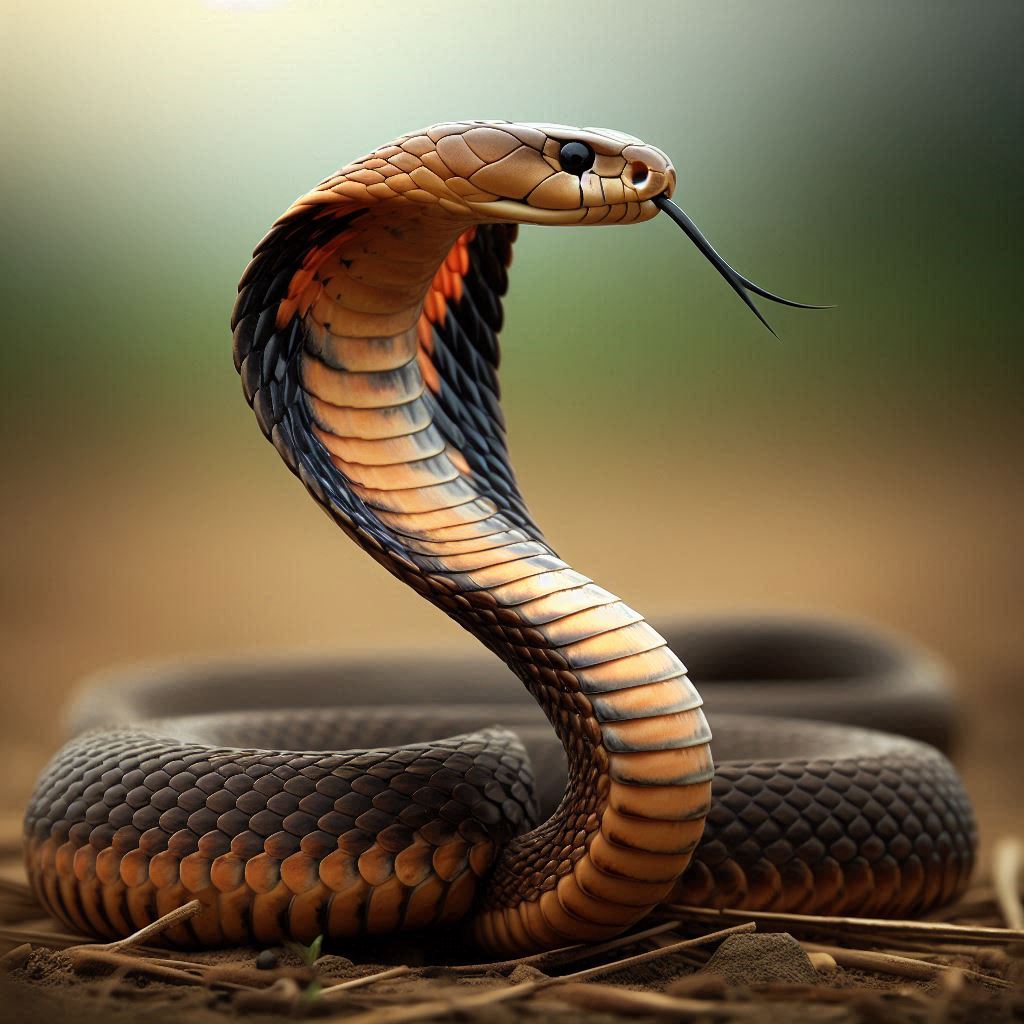
Classification
- Scientific name: Naja katiensis
- Class: Reptilia
- Domain: Eukaryota
- Family: Elapidae
- Kingdom: Animalia
- Subgenus: Naja
- Conservation status: Least Concern (IUCN)
Characteristics:
This species is characterized by its aggressive behavior and spitting ability. Its coloration is usually muted, allowing for effective camouflage.
Lifespan:
Typically lives around 10-15 years.
Prey and Diet:
The Mali Cobra preys on small mammals and occasionally birds, using its venom to immobilize its prey.
Behavior/Venom:
Its venom is highly neurotoxic, making it dangerous to potential predators and humans. This species is known for its spitting behavior when threatened.
Habitat:
It primarily inhabits savannas and open grasslands, preferring dry environments.
Geographic Range:
Found in Benin, Burkina Faso, Cameroon, Ghana, Guinea, Ivory Coast, Mali, Gambia, Mauritania, Niger, Nigeria, Senegal, and Togo.
Burrowing Cobra (Naja multifasciata)
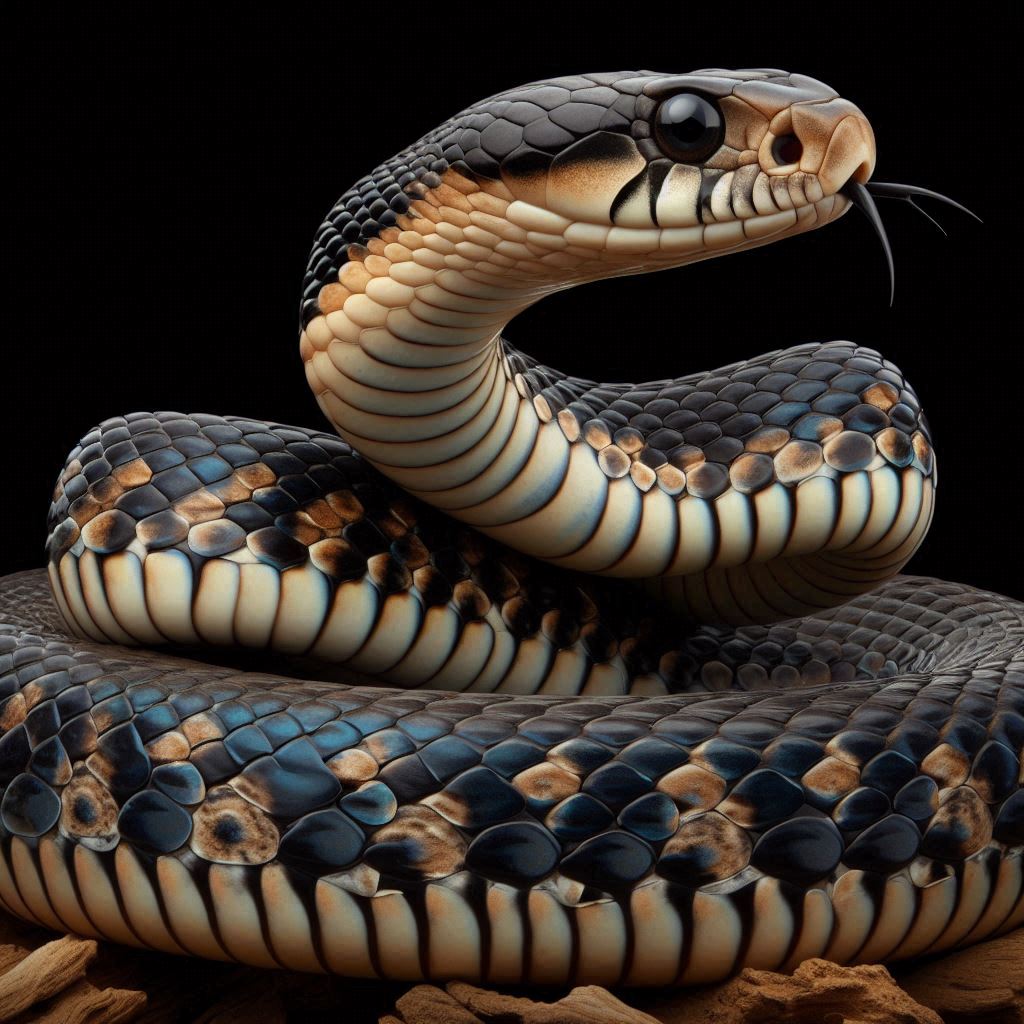
Classification
- Scientific name: Naja multifasciata
- Class: Reptilia
- Domain: Eukaryota
- Family: Elapidae
- Kingdom: Animalia
- Subgenus: Naja
- Conservation status: Least Concern (IUCN)
Characteristics:
The Burrowing Cobra has a slender body that is adapted for life underground. Its coloration varies but often includes shades of brown and tan for camouflage.
Lifespan:
Typically lives around 10-15 years in the wild.
Prey and Diet:
This species feeds primarily on small mammals and reptiles, using its venom to subdue its prey.
Behavior/Venom:
While not commonly seen, the Burrowing Cobra can exhibit defensive behaviors, using its venom to deter threats when encountered.
Habitat:
True to its name, it is adapted for burrowing and is often found in sandy soils.
Geographic Range:
Native to Cameroon, Congo, and the Democratic Republic of the Congo.
Andaman Cobra (Andaman Spitting Cobra) (Naja sagittifera)
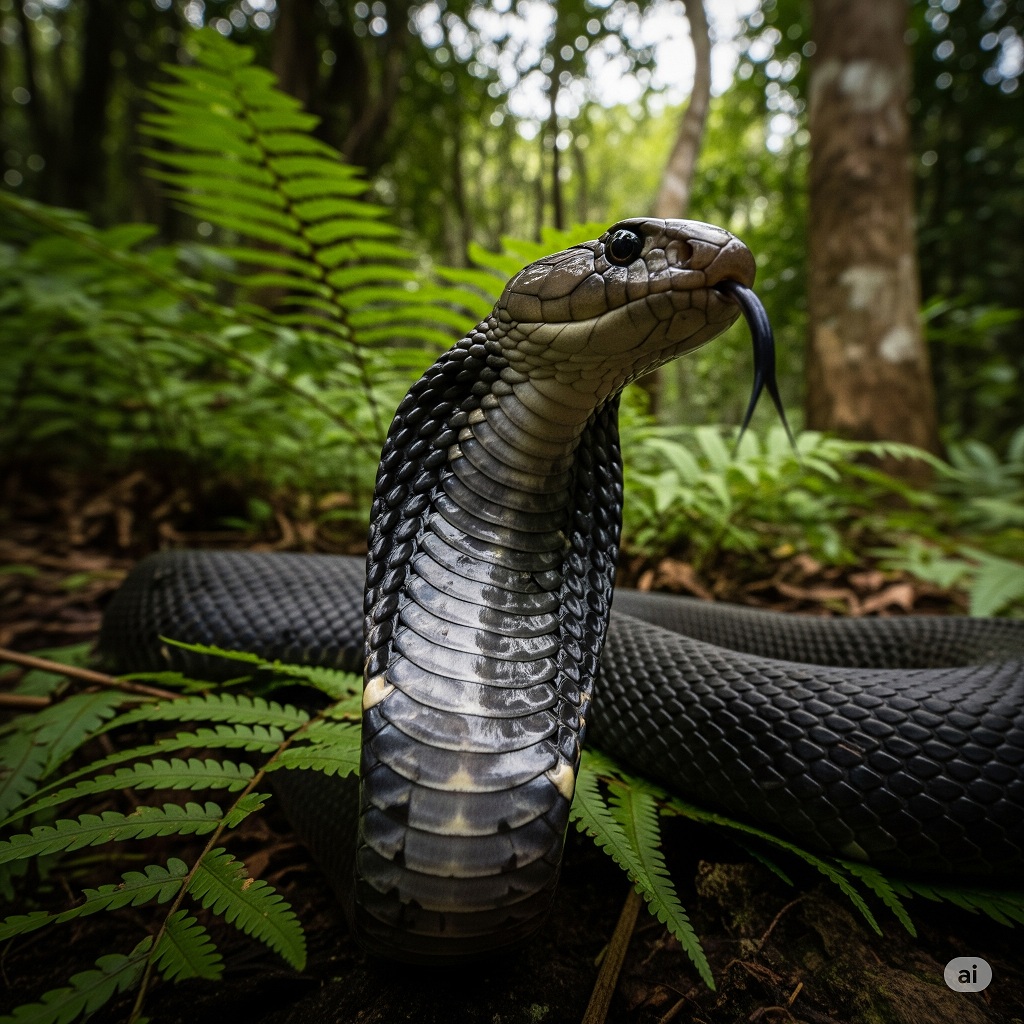
Classification
- Scientific name: Naja sagittifera
- Class: Reptilia
- Domain: Eukaryota
- Family: Elapidae
- Kingdom: Animalia
- Subgenus: Naja
- Conservation status: Least Concern (IUCN)
Characteristics:
The Andaman Cobra has a robust build and a potentially variable coloration. It is noted for its potent venom.
Lifespan:
Typically lives around 10-15 years.
Prey and Diet:
This species preys on small mammals and reptiles, using its venomous bite to immobilize prey.
Behavior/Venom:
The venom is potent and can cause severe effects in humans; defensive behavior may include spitting.
Habitat:
Found in tropical rainforests and hilly regions of the Andaman Islands.
Geographic Range:
Endemic to the Andaman Islands, India.
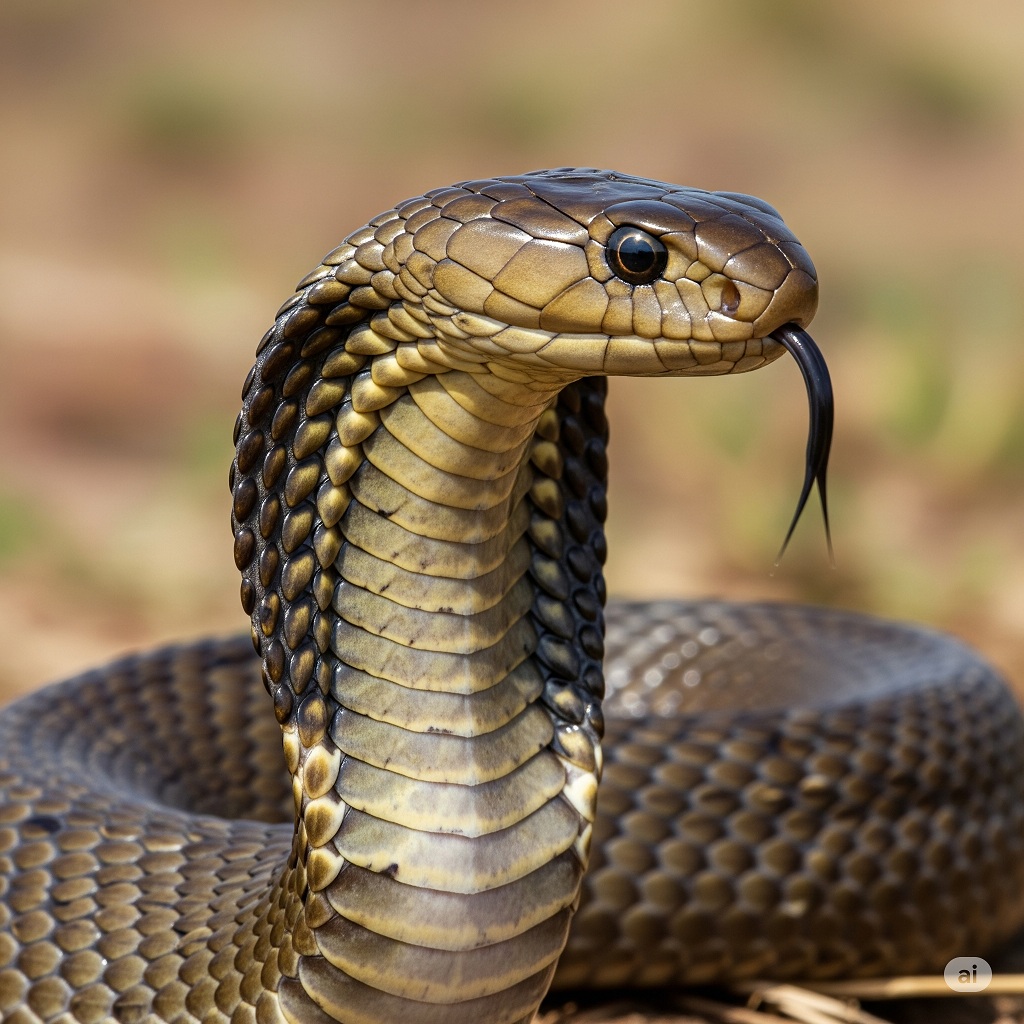
Senegalese Cobra
Classification
- Scientific name: Naja senegalensis
- Class: Reptilia
- Domain: Eukaryota
- Family: Elapidae
- Kingdom: Animalia
- Subgenus: Naja
- Conservation status: Least Concern (IUCN)
Characteristics:
The Senegalese Cobra exhibits a slender profile with a significant color variation, typically displaying patterned scales.
Lifespan:
Generally lives around 10-15 years.
Prey and Diet:
It primarily feeds on small mammals, birds, and amphibians, utilizing both its spitting and biting capabilities.
Behavior/Venom:
This species is capable of spitting venom with precision, and its neurotoxic venom can lead to severe effects on humans and other large animals.
Habitat:
Found in savannas, forests, and areas near water sources.
Geographic Range:
Distributes through Benin, Burkina Faso, Ghana, Guinea, Mali, Niger, Nigeria, and Senegal.
Equatorial Spitting Cobra
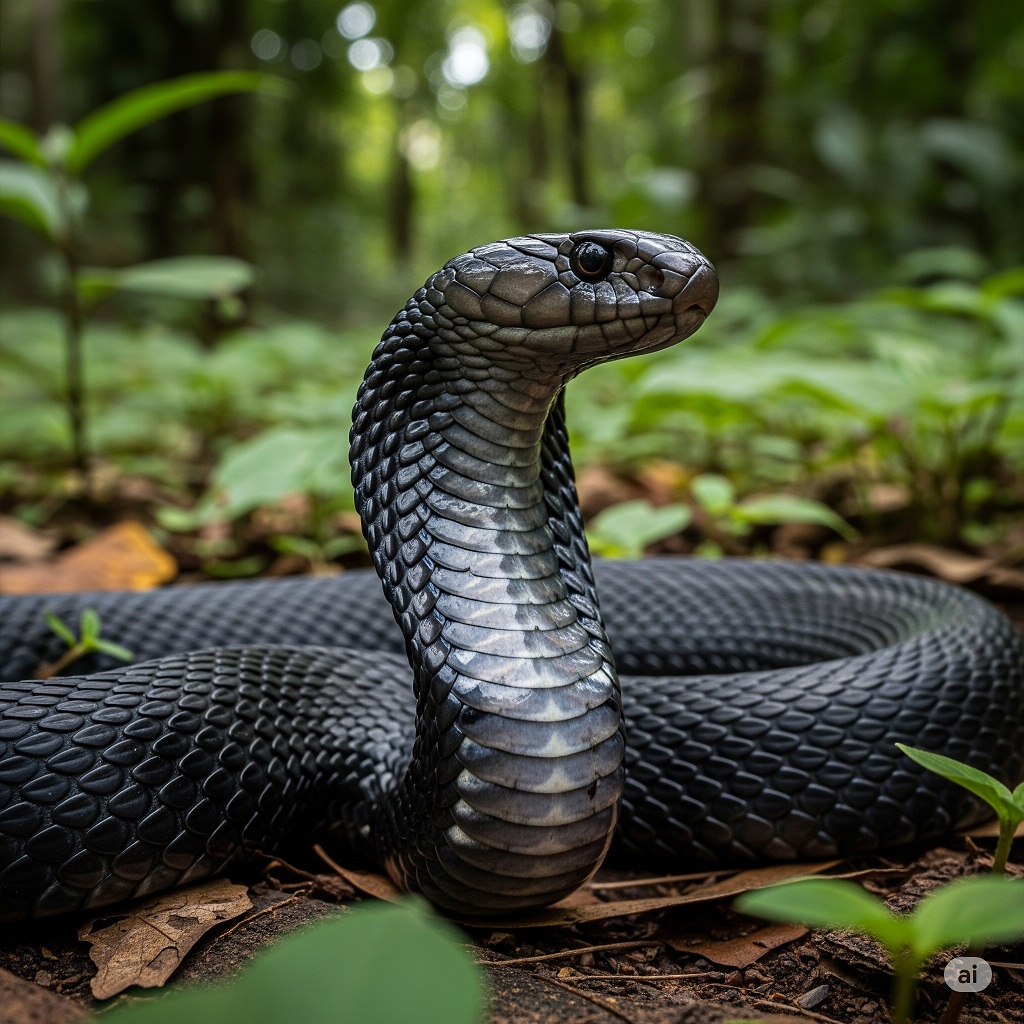
Classification
- Scientific name: Naja sumatrana
- Class: Reptilia
- Domain: Eukaryota
- Family: Elapidae
- Kingdom: Animalia
- Subgenus: Naja
- Conservation status: Least Concern (IUCN)
Characteristics:
The Equatorial Spitting Cobra features a robust body and variable coloration, often adapting to local environments for camouflage.
Lifespan:
Typically lives around 10-15 years.
Prey and Diet:
Feeds on a variety of small animals, including mammals and birds, and uses its venom for immobilizing prey.
Behavior/Venom:
Possesses the ability to accurately spit venom as a defensive mechanism. Its venom is potent and can cause serious injuries.
Habitat:
Prefers humid, forested environments, often found near rivers and wetland areas.
Geographic Range:
Endemic to Southeast Asia, particularly in Sumatra and Borneo.
Mandalay Spitting Cobra (Burmese Spitting Cobra)
Classification
- Scientific name: Naja mandalayensis
- Class: Reptilia
- Domain: Eukaryota
- Family: Elapidae
- Kingdom: Animalia
- Subgenus: Naja
- Conservation status: Least Concern (IUCN)
Characteristics:
This cobra is known for its impressive size and the ability to spit venom accurately. Its coloration ranges from brown to gray.
Lifespan:
Typically lives around 10-15 years.
Prey and Diet:
It preys on small mammals and birds, using venom for immobilization.
Behavior/Venom:
The Mandalay Spitting Cobra is known for its potent venom, which can cause severe reactions in humans.
Habitat:
This species prefers forested and agricultural areas where it can find ample prey.
Geographic Range:
Found primarily in Burma (Myanmar).
Nubian Spitting Cobra
Classification
- Scientific name: Naja nubiae
- Class: Reptilia
- Domain: Eukaryota
- Family: Elapidae
- Kingdom: Animalia
- Subgenus: Naja
- Conservation status: Least Concern (IUCN)
Characteristics:
The Nubian Spitting Cobra has a slender build and distinctive markings on its hood. It can display a variety of colors from brown to yellow.
Lifespan:
Typically lives around 10-15 years.
Prey and Diet:
It predominantly feeds on small rodents and birds, using its neurotoxic venom to immobilize its prey.
Behavior/Venom:
This species exhibits strong defensive behavior, including spitting venom to deter threats. Its venom can cause intense pain and systemic effects if it enters the body.
Habitat:
Prefers arid and semi-arid habitats, including parts of deserts and scrublands.
Geographic Range:
Found mainly in Chad, Egypt, Eritrea, Niger, and Sudan.
Spanish Cobra (black-necked spitting cobra)
Classification
- Scientific name: Naja iberica
- Class: Reptilia
- Domain: Eukaryota
- Family: Elapidae
- Kingdom: Animalia
- Subgenus: Naja
- Conservation status: Extinct (Information primarily from fossil records)
Characteristics:
Known primarily from fossil records, it exhibits characteristics typical of other cobras.
Lifespan:
Lifespan details are not documented due to its absence in living specimens.
Prey and Diet:
Little is known regarding its diet, but it likely preyed on small animals similar to its living relatives.
Behavior/Venom:
Similar venom characteristics are inferred from relatives, primarily neurotoxic effects.
Habitat:
Identified from Miocene-aged strata, specific habitat details are limited.
Geographic Range:
Historical distribution includes Miocene-aged strata of Spain.
Black-Necked Spitting Cobra
Classification
- Scientific name: Naja nigricollis
- Class: Reptilia
- Domain: Eukaryota
- Family: Elapidae
- Kingdom: Animalia
- Subgenus: Naja
- Conservation status: Least Concern (IUCN)
Characteristics:
The Black-Necked Spitting Cobra has a distinct black neck and a lighter body. It can reach lengths of about 1.5 meters (5 feet).
Lifespan:
Typically lives around 10-15 years.
Prey and Diet:
This species primarily preys on small mammals, birds, and other small reptiles.
Behavior/Venom:
Known for its aggressive nature, the venom contains neurotoxic components that can lead to severe complications in humans if bitten.
Habitat:
Found in various habitats, including savannas, forests, and near water sources.
Geographic Range:
Common throughout sub-Saharan Africa, including Angola, Benin, Burkina Faso, and several other countries.
Zebra Spitting Cobra
Classification
- Scientific name: Naja nigricincta
- Class: Reptilia
- Domain: Eukaryota
- Family: Elapidae
- Kingdom: Animalia
- Subgenus: Naja
- Conservation status: Least Concern (IUCN)
Characteristics:
The Zebra Spitting Cobra is characterized by its striking black-and-white striped pattern, resembling a zebra, which provides excellent camouflage.
Lifespan:
Typically lives around 10-15 years.
Prey and Diet:
It primarily preys on small mammals, birds, and reptiles, using its potent venom to immobilize them quickly during hunts.
Behavior/Venom:
This species is known for its spitting behavior, and its venom is highly neurotoxic, posing significant risks to humans.
Habitat:
Typically found in savannas and grasslands where it can easily camouflage.
Geographic Range:
Found in Angola, Namibia, and South Africa.
European Cobra
Classification
- Scientific name: Naja romani
- Class: Reptilia
- Domain: Eukaryota
- Family: Elapidae
- Kingdom: Animalia
- Subgenus: Naja
- Conservation status: Extinct (known primarily from fossils)
Characteristics:
The European Cobra is recognized mainly from fossilized remains. Its characteristics suggest it shared similarities with other venomous cobras.
Lifespan:
Details on lifespan are not available due to its extinction.
Prey and Diet:
Likely preyed on small animals similar to present-day cobras.
Behavior/Venom:
Information on its specific venom behavior is derived from relatives, suggesting neurotoxic properties.
Habitat:
The habitat is inferred from fossil records, likely similar to that of other cobras.
Geographic Range:
Known from Miocene-aged strata found in France, Germany, Austria, Romania, and Ukraine.
Conclusion
Each species of cobra, including the spitting varieties, has unique characteristics and adaptations that contribute to their survival in diverse environments. Understanding their behaviors, habitats, and conservation statuses is crucial for promoting awareness and protecting these fascinating reptiles. As we study and appreciate these snakes, we gain insights into the complex ecosystems they inhabit and the roles they play in maintaining biodiversity.

94% of pet owners say their animal pal makes them smile more than once a day. In 2007, I realized that I was made for saving Animals. My father is a Vet, and I think every pet deserves one. I started this blog, “InPetCare”, in 2019 with my father to enlighten a wider audience.
